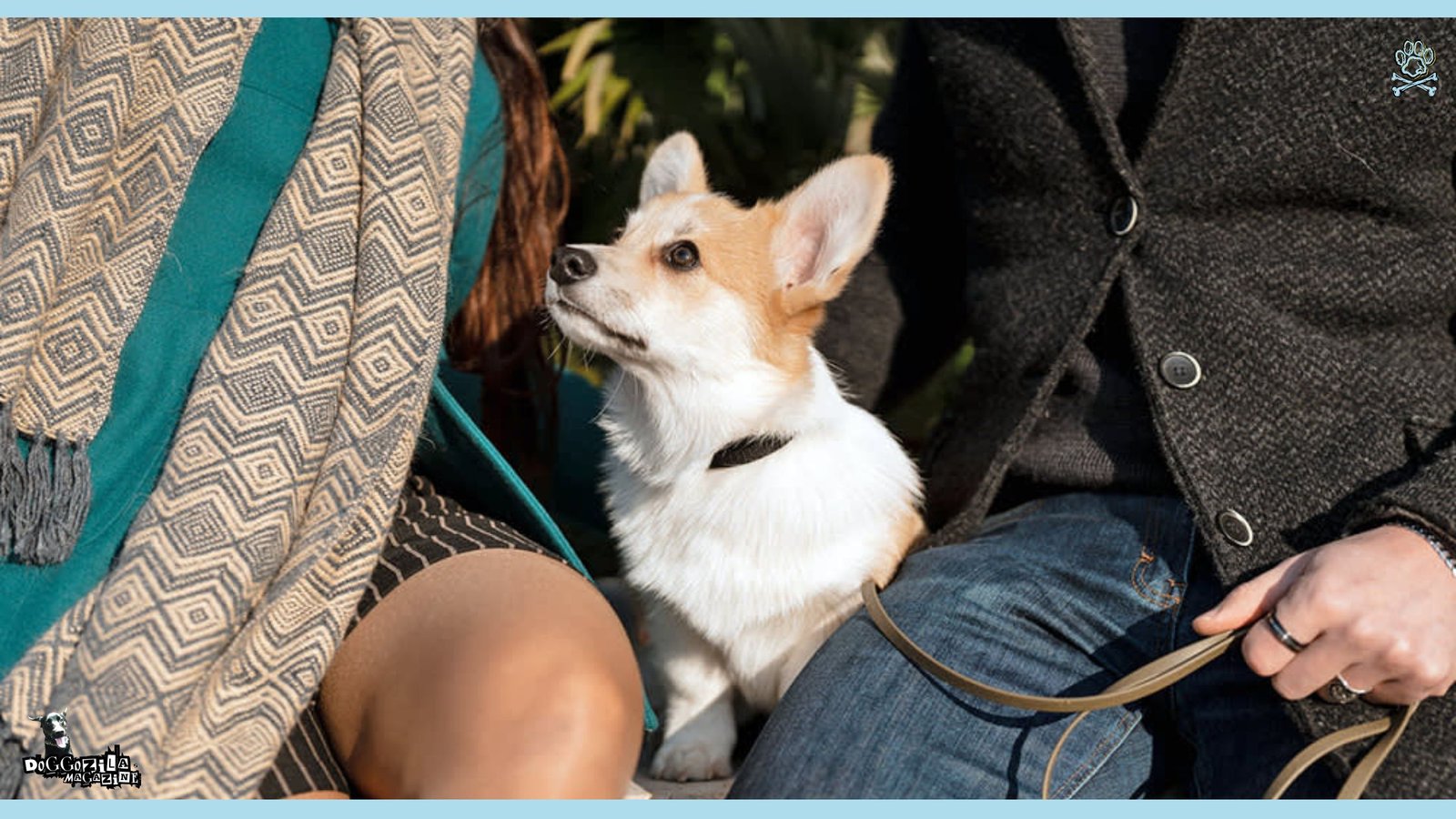As dog owners, we often wonder how much our furry friends truly understand when we chat away in their presence. Recent studies suggest that they can pick out meaningful words even when we’re not speaking directly to them. This raises the question about do dogs eavesdrop on humans as part of their survival and bonding instincts? Understanding this behavior can help us strengthen our communication and deepen our bond with our pets.
This article explores the fascinating world of dog cognition and communication, answering the burning question if dogs eavesdrop on humans? Through research insights and practical observations and experiments, we’ll uncover how dogs process human speech, why this ability matters for our relationship with them, and how we can better communicate with our four-legged family members.
That innocent-looking dog napping in the corner?
They’re not sleeping, but they’re eavesdropping on your every word,
and science confirms it!

HOW DO DOGS EAVESDROP ON HUMANS DURING EVERYDAY CONVERSATIONS?
Dogs often lie quietly nearby, but their ears are working overtime. They can detect subtle changes in tone, pitch, and rhythm, even when the words aren’t directed at them. This skill may have evolved from their need to interpret human cues for food, safety, or affection.
Many owners notice their dogs reacting to certain phrases like “walk” or “treat” even when whispered. This shows that dogs are not just passive listeners but active interpreters. Their ability to filter relevant information from background chatter is a sign of advanced social intelligence. It’s one of the many reasons they feel so in tune with us. And it’s why they sometimes seem to know what we’re thinking before we say it.
Research Confirm That Dogs Do Eavesdrop On Humans During All Conversations
Everyday scenarios provide compelling evidence that dogs do indeed eavesdrop on human conversations. When you’re chatting with family members or on the phone, you might notice your dog perking up at certain words like “walk,” “treat,” or their name. This isn’t just selective hearing, but it’s evidence of their sophisticated monitoring of our speech.
Research confirms that dogs can identify relevant keywords buried within longer sentences and spoken in normal conversational tones. This ability allows them to gather information about upcoming activities or events that might concern them directly, even when they’re not directly addressed.
Real-Life Examples of Eavesdropping Dogs
Many dog owners have amusing stories about their pets reacting to conversations not meant for them. Your dog might suddenly appear when you mention “park” to your partner or begin pacing excitedly when you discuss “dinner” with a friend. These behaviors demonstrate how dogs constantly monitor our conversations for personally relevant information.
Some particularly attentive dogs even learn words beyond the usual commands, responding to unexpected phrases like “vet visit” or “bath time” with appropriate anticipation or avoidance behaviors. These real-world observations align with scientific findings that dogs extract meaningful content from speech streams.
How Do Dogs Eavesdrop on Humans for Relevant Info From Background Chatter?
Dogs appear to have developed mental filters that help them identify personally significant words amid constant human chatter. This ability requires sophisticated auditory processing and cognitive prioritization mechanisms. Research suggests that dogs pay particular attention to words that have consistent consequences in their lives, such as their name, command words, or activity-related terms.
They likely combine this speech monitoring with other cues like our body language and routines to form predictions about future events. This filtering system enables dogs to ignore much of our meaningless chatter while remaining alert to conversation snippets that genuinely matter to them. Dogs are masters of observation, and their listening skills are part of that package. They may be gathering information to predict what will happen next.
For example, hearing the sound of keys might mean a walk or a car ride. This anticipation is part of their survival strategy. Even in multi-dog households, one dog might “listen in” to gain an advantage over the others. This behavior is not about spying, but it’s about staying connected. And it’s a testament to their adaptability in human environments.
The Evolutionary Advantage of Monitoring Human Speech
From an evolutionary perspective, dogs that could effectively monitor human speech likely had survival and reproductive advantages. Dogs that understood more human communication would have been more valuable to early human societies, receiving better care and resources. This ability would have been particularly useful for working dogs who needed to respond to commands and anticipate tasks.
Even in modern pet dogs, this skill strengthens the human-animal bond and ensures their needs are met. The constant monitoring of human conversations represents an adaptive strategy that has been reinforced through thousands of years of domestication.
Do Dogs Eavesdrop on Humans to Learn New Commands and Gauge Our Mood?
Training often involves repetition, but dogs can also learn by overhearing. If they hear a command given to another dog, they may start to understand it without direct teaching. This is a form of social learning seen in intelligent species. It’s why group training classes can be so effective.
Dogs watch, listen, and then try the behavior themselves. This ability to learn indirectly is another sign of their cognitive flexibility. And it’s one more reason to be mindful of what we say around them. Dogs don’t just hear words, but they feel the emotions behind them.
They can detect stress, joy, or sadness in our voices. This emotional eavesdropping helps them decide how to respond. It’s why they might cuddle closer when we’re upset. Or why they get excited when we sound happy. Their sensitivity to our emotional state is part of what makes them such empathetic companions. And it’s a skill that deepens the human-dog bond.
🔑 Key Points: Dogs actively interpret human speech by detecting subtle changes in tone, pitch, and rhythm, filtering relevant words like “walk” or “treat” from background chatter as a sign of their advanced social intelligence.

THE SCIENCE BEHIND DOG SPEECH RECOGNITION
Dogs possess remarkable neurological capabilities that allow them to process human speech in ways we’re only beginning to understand. Research conducted by animal behavior experts at the Universities of Lincoln and Sussex demonstrates that dogs can pick out relevant information from human speech, even when it’s not directed at them. This ability to extract meaningful content from monotonous streams of conversation suggests sophisticated cognitive processing.
The study found that dogs respond to familiar words and commands even when delivered in a flat tone without the usual exaggerated intonation we typically use with pets. This research provides compelling evidence that dogs are actively processing our conversations rather than simply responding to tone or context cues.
Neurological Foundations of Dog Speech Processing
The dog brain contains specialized regions that process human vocal signals, similar to how human brains process speech. Studies using functional MRI scans have shown that dogs process words with their left hemisphere and intonation with their right hemisphere, much like humans do. This neurological specialization allows dogs to separate the content of speech from the emotional tone in which it’s delivered.
The ability to process human speech appears to be enhanced in dogs compared to their wolf ancestors, suggesting domestication has shaped their cognitive abilities. This specialized brain architecture enables dogs to recognize words regardless of who speaks them, a phenomenon known as speaker normalization.
The Habituation-Dishabituation Paradigm Explained
Research methodology plays a crucial role in understanding canine speech perception. Scientists often use the habituation-dishabituation paradigm, where dogs are repeatedly exposed to a stimulus until their response decreases (habituation), then presented with a new stimulus to measure renewed interest (dishabituation).
This approach has demonstrated that dogs can spontaneously recognize the same words across different speakers and differentiate between unfamiliar speakers saying the same words. These experiments reveal that dogs possess perceptual abilities once thought to be uniquely human. The methodology provides robust evidence that dogs aren’t merely responding to simple cues but are actively processing speech patterns.
Comparative Studies With Other Mammals
While dogs show remarkable speech processing abilities, researchers wonder if other species share similar capabilities. Studies comparing dogs to wolves suggest that domestication has enhanced dogs’ ability to understand human communication. Ongoing research is investigating whether wolves and other wild canids possess similar speech recognition skills or if this is a unique adaptation in domestic dogs.
Some evidence suggests that other domesticated animals like cats may have some similar abilities, though likely to a lesser degree. Understanding these comparative aspects helps scientists determine whether dog speech perception represents a special case of cross-species communication or a more general mammalian capability.
Do Dogs Eavesdrop On Humans More Than Other Pets?
When considering whether dogs eavesdrop on humans more than other pets, evidence suggests dogs possess exceptional abilities in this domain compared to other domesticated animals. While cats and some other pets can learn to recognize specific words or tones, dogs appear uniquely adept at extracting meaningful content from continuous human speech.
This likely results from their long history of working alongside humans in tasks requiring communication. However, limited comparative research means we shouldn’t underestimate the capabilities of other species. Each animal species has evolved communication skills suited to its ecological niche and relationship with humans.
Canine Versus Feline Speech Perception Abilities
While cats can certainly recognize their names and some familiar words, research suggests dogs have more advanced abilities to process human speech. Dogs’ evolutionary history as working animals who followed human commands likely selected for enhanced speech processing capabilities.
Cats, with a different domestication history and less reliance on human vocal communication for cooperative work, may not have developed the same level of speech processing specialization. However, cat owners shouldn’t feel left out, as felines excel at interpreting other human signals like gestures and facial expressions. Each species has developed communication strengths suited to its relationship with humans.
Why Dogs Might Be Unique in Their Eavesdropping Abilities?
Dogs’ exceptional eavesdropping abilities likely stem from their unique evolutionary trajectory alongside humans. No other species has been bred for such a wide variety of cooperative tasks with humans, from herding and hunting to assistance and protection. These roles required dogs to attend carefully to human communication, including subtle vocal cues.
Additionally, dogs have been specifically selected for their responsiveness to humans throughout their domestication history. This has resulted in a species exquisitely tuned to human vocalizations, capable of monitoring our conversations for information relevant to their lives and needs.
Considerations for Multi-Pet Households
In households with both dogs and other pets, interesting dynamics can emerge around which animals respond to human speech. Owners often report that their dogs seem more attentive to conversations than other pets, consistently being first to react to words like “walk” or “treat.”
However, other pets like cats may learn to respond to these words after observing the dog’s reaction. This suggests that in multi-pet environments, some animals may leverage the eavesdropping capabilities of their dog housemates. These dynamics create complex communication environments where different species interact with human speech in complementary ways.
🔑 Key Points: Scientific studies confirm that dogs possess sophisticated neurological capabilities, allowing them to process and extract meaningful content from human speech even when it’s delivered in a flat, monotone voice without exaggerated intonation.

HOW DOGS DIFFERENTIATE SPEECH PATTERNS AND TONES
Dogs exhibit remarkable proficiency in distinguishing between different speech patterns and tones, processing both the semantic content and emotional prosody of human speech. Dogs appear to integrate multiple auditory cues including pitch, tone, and word patterns to derive meaning from human speech.
Research shows that while dogs prefer and more easily recognize the exaggerated intonation of dog-directed speech (similar to “baby talk“), they can also identify words and commands when delivered in a flat, monotone voice. This demonstrates that they’re processing the actual phonetic content of words, not just responding to emotional cues.
The Special Role of Dog-Directed Speech
Dog-directed speech (DDS) characterized by higher pitch, exaggerated intonation, and simplified vocabulary, captures canine attention more effectively than normal speech. This speech register closely resembles infant-directed speech (“baby talk“) that humans use with young children.
Studies indicate that dogs are more responsive to commands delivered in DDS, particularly when learning new tasks or commands. However, research also shows that once dogs learn specific words, they can recognize them even without the exaggerated DDS prosody. This suggests that while DDS serves as an attention-getter, dogs are capable of processing the actual word content regardless of delivery style.
Dog Processing of Phonetic Elements in Human Speech
Dogs demonstrate an impressive ability to distinguish between similar-sounding words and phonemes, suggesting sophisticated auditory discrimination capabilities. Research using the habituation-dishabituation paradigm has shown that dogs can recognize the same words across different speakers and differentiate between subtle phonetic variations.
They can form mental categories for vowel sounds despite variations in speaker gender, pitch, or tone. This phonetic processing ability enables dogs to identify familiar words even when embedded in longer sentences or spoken in unfamiliar voices. These skills are particularly remarkable considering dogs don’t use language themselves yet have adapted to process human vocalizations.
The Interaction Between Tone and Content Recognition
While dogs can process word content independent of tone, the combination of meaningful words and engaging prosody produces the strongest responses. Research indicates that dogs respond most strongly to familiar commands or their name when both the word content is relevant and the delivery uses appealing dog-directed speech.
The emotional tone of speech appears to provide contextual information that helps dogs interpret the meaning and urgency of utterances. This integration of content and tone processing suggests dogs have developed sophisticated multimodal speech processing capabilities through their long association with humans.
How Do Dogs Eavesdrop On Humans To Offer Comfort or Avoid Conflict?
When a dog senses sadness in our voice, they often approach gently. They may rest their head on our lap or bring a favorite toy. This is not random, but it’s a learned response from years of shared experiences. Dogs associate certain tones with specific outcomes.
Over time, they refine their reactions to match our needs. This is why therapy dogs are so effective in hospitals and care homes. They’re not just trained, but they’re emotionally attuned. And that attunement often starts with quiet listening. Dogs in multi-person households may listen for signs of tension. Raised voices or sharp tones can signal that it’s time to retreat.
This is a self-preservation tactic rooted in their pack instincts. In the wild, avoiding conflict could mean survival. At home, it means finding a safe spot until things calm down. This shows that eavesdropping isn’t always about curiosity, but it can be about safety. And it’s another example of how dogs adapt to our social dynamics.
Do Dogs Eavesdrop on Humans for Joyful Moments and Food Opportunities?
Dogs love to be part of the fun. If they hear laughter or excited voices, they often come running. This is because they associate those sounds with play, treats, or affection. Over time, they learn which tones mean “good things are happening.” This makes them more likely to engage when they sense joy. It’s part of their social integration into our families. And it’s one reason they seem to “magically” appear when the party starts.
Food is a powerful motivator for dogs. They quickly learn the sounds and words that lead to snacks. This includes overhearing conversations about dinner or treats. Their acute hearing allows them to pick out these cues even from another room. This skill is part instinct, part learned behavior. And it’s one of the most relatable examples of dog eavesdropping.
🔑 Key Points: Dogs proficiently process both the semantic content (the word itself) and the emotional prosody (the tone) of human speech, integrating these auditory cues to derive meaning, though they can recognize words independently of delivery style.

THE ROLE OF DOMESTICATION IN DOG LISTENING SKILLS
The extraordinary speech perception abilities of dogs likely result from thousands of years of domestication and co-evolution with humans. As dogs and humans have lived symbiotically for over 14,000 years, natural selection would have favored dogs who could better understand human communication.
Research comparing dogs to wolves suggests that domestication enhanced dogs’ ability to interpret human gestures and vocalizations. However, scientists continue to debate whether dogs’ speech processing abilities represent a special adaptation to human communication or simply exploit general mammalian auditory capabilities. The ongoing research with wolves and other canids aims to resolve this question.
Historical Development of Human-Dog Communication
The mutualistic relationship between humans and dogs has created evolutionary pressures that enhanced dog communication skills. Dogs that could better understand human vocalizations, gestures, and intentions would have been more valuable working partners and companions. This historical partnership has shaped dog cognition toward specialized processing of human social signals.
Archaeological evidence suggests that as humans and dogs co-evolved, communication abilities improved on both sides, but humans became better at reading dog signals and dogs became more responsive to human communication. This long shared history has created a unique cross-species communication system unlike any other in the animal kingdom.
Genetic Factors Influencing Dog Speech Perception
Recent research suggests that genetic factors may influence individual dogs’ abilities to understand human speech. Certain breeds developed for working roles requiring communication with humans, such as herding or hunting breeds, may show enhanced speech processing capabilities.
However, studies involving diverse breeds have found that dogs across breed categories can recognize words in continuous speech. This suggests that while breeding for specific functions may have refined these abilities, the capacity for human speech recognition is widespread among domestic dogs. Genetic research continues to identify specific markers that might be associated with exceptional communication skills in dogs.
Comparative Research With Wolves and Wild Canids
Research comparing dogs to wolves raised in human environments helps scientists understand how domestication shaped dog communication abilities. While socialized wolves can learn to respond to some human commands, they appear less adept at spontaneously recognizing words in continuous speech. This suggests that domestication enhanced dogs’ innate predisposition to attend to and process human vocalizations.
However, some researchers caution that more studies are needed to fully understand the differences between dogs and wolves, as wolf intelligence manifests differently than canine intelligence. These comparative studies help unravel the complex interplay between evolutionary adaptation and individual learning in dog speech perception.
Dog Listening Evolved with Their Eavesdropping, Now They Can Predict Their Mealtime
The kitchen is a hotspot for dog listening. Dogs often linger nearby, ears perked for the sound of a fridge door or snack bag. They can even recognize the sound of specific containers. This shows how their listening skills are tied to survival instincts. In the wild, sound cues could mean food availability.
At home, it means a chance for a tasty reward. And it’s why many dogs seem to “teleport” into the kitchen at the right moment. Dogs thrive on routine, and mealtime is a big part of that. They learn the sequence of events leading up to feeding.
This might include hearing the clink of bowls or the rustle of kibble bags. Even casual mentions of “dinner” can trigger excitement. This predictive listening shows how dogs connect sounds to outcomes. It’s a skill that keeps them in sync with our schedules. And it’s one reason they’re such reliable timekeepers.
Related Article Recommendation:
Counter-Surfing Dogs: How To Stop This Behavior?
How Do Dogs Eavesdrop on Humans to Get Extra Treats or to Improve Training?
Some dogs are experts at manipulating situations for snacks. They might overhear a guest asking if they can give the dog a treat. This prompts them to appear at just the right moment. It’s a clever use of eavesdropping to get what they want. Over time, they refine this skill to maximize rewards. This shows that listening is not just passive, but it can be strategic. And it’s one more reason to watch what we say around them.
Training doesn’t always happen in formal sessions. Dogs can pick up cues and commands from overhearing. This is especially true in multi-dog households. One dog’s training can benefit another through observation and listening. This makes eavesdropping a valuable tool for learning. And it’s a reminder that dogs are always paying attention.
In group classes, dogs often watch and listen to others. They may try a command after seeing another dog succeed. This is a form of social learning that speeds up training. It also builds confidence as they see peers rewarded. Trainers can use this to their advantage. By pairing experienced dogs with beginners, learning accelerates. And it all starts with attentive listening.
🔑 Key Points: Dogs’ exceptional speech perception abilities are likely the result of thousands of years of co-evolution with humans, where natural selection favored dogs that could better understand human communication for survival and bonding.

PRACTICAL EXPERIMENTS TO TEST IF YOUR DOG IS EAVESDROPPING
Curious owners can conduct simple experiments at home to test whether their dogs are eavesdropping on human conversations. These exercises can be both fun and enlightening, revealing much about your dog’s cognitive abilities. Before beginning, remember to keep sessions short and positive, rewarding your dog for participation.
The goal isn’t to test intelligence but to better understand how your dog processes human speech. Always end on a positive note with plenty of praise and perhaps a treat, ensuring your dog associates these activities with enjoyable interactions.
The Neutral Tone Name Recognition Test
This experiment tests whether your dog can recognize their name when spoken in a neutral tone within a sentence. Wait until your dog is relaxed but not asleep, and have a partner engage you in casual conversation. Within this conversation, include a sentence that contains your dog’s name spoken in a completely neutral tone, such as “I was thinking about [dog’s name] bowl earlier and wondered if we should get a new one.”
Watch for subtle signs of recognition like ear movement, head turning, or shifting attention toward you. Repeat this with different sentence structures to see if your dog consistently responds to their name despite neutral delivery and surrounding conversation.
The Embedded Command Response Assessment
Dogs often learn commands in isolation with clear intonation, but this test examines whether they recognize commands embedded in normal speech. Have a conversation with someone in which you include a familiar command like “sit” or “down” within a sentence spoken in a neutral tone, such as “I need to sit down on that chair over there.”
Avoid any gesture or body language that might cue your dog. Observe whether your dog responds to the embedded command despite its conversational context and neutral delivery. Try this with different commands to assess how well your dog extracts meaningful action words from continuous speech.
The Novel Word Detection Experiment
This more advanced test examines whether dogs can detect and respond to new words they haven’t been explicitly taught. Choose a nonsense word your dog hasn’t heard before, but make it sound similar to familiar words. Use this word in conversation repeatedly over several days in contexts that would be relevant to your dog, such as “I’m going to get the [novel word] now” before feeding times.
After several exposures, see if your dog begins to respond to this novel word with feeding-time anticipation. This experiment tests your dog’s ability to extract and associate new meaningful words from conversational context without explicit training.
Do Dogs Eavesdrop on Humans to Learn Household Rules and The Boundaries?
Dogs can learn rules without direct correction. If they overhear you telling another dog “off the couch,” they may avoid it themselves. This saves time and reduces stress for owners. It also shows how dogs adapt to shared environments. Over time, they build a mental map of acceptable behavior. This makes them easier to live with. And it’s another benefit of their eavesdropping skills.
Boundaries are important for harmony in the home. Dogs can learn these by overhearing consistent cues. For example, hearing “stay” at the door teaches them not to rush out. This indirect learning is efficient and low-stress. It also strengthens trust between dog and owner. And it’s a subtle way to reinforce good manners.
Dogs are excellent judges of character. They may listen to interactions to decide who is safe. This is especially true with strangers. Over time, they build a trust profile based on what they hear. This skill likely evolved from their pack instincts. And it’s one more way they navigate our complex social world.
Related Article Recommendation:
How to Keep Dogs Off the Couch: Win The Battle
🔑 Key Points: Owners can conduct simple at-home tests, like saying the dog’s name in a neutral tone within a sentence, to observe subtle signs of recognition and assess their dog’s ability to extract meaningful words from continuous speech.

UNDERSTANDING THE LIMITATIONS OF DOG LANGUAGE COMPREHENSION
While dogs possess impressive speech processing abilities, it’s important to understand the limitations of their language comprehension. Dogs don’t understand human language with the complexity that humans do, but they associate specific sounds with outcomes rather than understanding syntax or abstract meaning.
Research suggests dogs typically understand around 89 words on average, with exceptional dogs knowing more than 200 words. However, this vocabulary consists mainly of nouns and verbs directly related to their experiences. Dogs lack the cognitive machinery for processing abstract concepts or complex grammar that characterizes human language understanding.
The Difference Between Signal Recognition and Language Comprehension
It’s crucial to distinguish between true language comprehension and signal recognition in dogs. When dogs respond to words like “walk” or “treat,” they’re likely associating these sounds with specific outcomes rather than understanding them as symbolic representations. This associative learning is different from human-like language comprehension that involves understanding words as elements in a structured system.
Dogs excel at picking out relevant signals from speech and connecting them to outcomes, but this doesn’t mean they understand the linguistic content in the way humans do. Recognizing this distinction helps us set appropriate expectations for canine communication abilities.
Contextual Factors That Influence Dog Speech Processing
Multiple contextual factors beyond the speech itself influence how dogs process human utterances. Dogs integrate tone of voice, body language, environmental context, and routine patterns when interpreting human speech. Research shows that dogs often rely more on these contextual cues than the actual word content when determining meaning.
This is why a dog might respond differently to the same word spoken in different contexts or by different people. Understanding these contextual influences helps explain why dogs sometimes seem to understand complex conversations while at other times fail to respond to clear commands.
Individual Differences in Dog Listening Abilities
Just like humans, dogs show individual differences in their speech processing abilities. Factors such as breed, age, training, and individual temperament all influence how well a dog understands human speech. Research indicates that dogs bred for working roles that require communication with humans may show enhanced language capabilities.
Older dogs may experience declines in hearing and cognitive function that affect their speech processing. Additionally, dogs with more training generally respond to more words and commands. Recognizing these individual differences helps owners tailor their communication to their specific dog’s abilities.
How Do Dogs Eavesdrop On Humans In Social Settings to Avoid Some People?
At gatherings, dogs often hang back and listen. They may approach people with friendly tones and laughter. This shows they’re using sound to assess safety. It’s a smart way to avoid negative experiences. Owners can use this to introduce dogs to new people. By letting them listen first, they feel more comfortable. And it makes socialization smoother.
Dogs can detect hostility in voices. This helps them steer clear of potential threats. It’s a survival skill that still serves them today. Even without visual cues, they can sense tension. This makes them excellent companions for personal safety. And it’s another reason they’re so attuned to our conversations.
Many owners notice their dogs gravitate toward certain people. This can be based on tone, kindness, or frequency of positive words. Dogs remember these patterns over time. This selective bonding is part of their emotional intelligence. And it’s shaped by what they overhear. Dogs often recognize the sounds of fun before it even starts. The jingle of a leash, the squeak of a toy, or the rustle of a ball bag can send them into a frenzy.
They may also respond to overheard phrases like “let’s go” or “want to play” even if you weren’t talking to them. This is because they’ve linked those sounds to positive experiences. Over time, they become experts at detecting the earliest signs of play. This anticipation is part of what makes them so joyful to be around. And it’s a reminder that our words and actions are always under their radar.
🔑 Key Points: It’s important to distinguish that dogs associate specific sounds with outcomes through signal recognition rather than understanding abstract language or complex grammar like humans do.

DO DOGS EAVESDROP ON HUMANS TO JOIN FAMILY ACTIVITIES TO RELIEVE BOREDOM?
Many dogs don’t want to miss out on anything. If they hear talk about a hike, a car ride, or a trip to the park, they’re suddenly at the door. This is not coincidence, but it’s learned behavior from years of listening. They know which conversations lead to adventure. This makes them active participants in family life. And it’s one reason they’re so deeply woven into our routines. Their ability to “invite themselves” is part of their charm.
Sometimes, listening in is simply entertainment. Dogs left alone in a room may still perk up at distant voices. This mental stimulation helps break up their day. It’s a way to stay connected even when they’re not directly involved. Over time, they may even learn to predict when something interesting will happen. This keeps their minds sharp and engaged. And it’s a subtle reminder that they’re always part of our world, even in the background.
Do Dogs Eavesdrop on Humans as a Survival Instinct to Detect Danger?
Long before they were pets, dogs relied on listening to survive. In the wild, overhearing the right sound could mean finding food or avoiding danger. Today, those instincts are still present. They help dogs navigate our homes and social lives. This makes eavesdropping a blend of ancient survival skills and modern companionship. And it’s one of the many ways they’ve adapted to life alongside us.
Dogs can pick up on alarm in our voices before we even realize we’re stressed. This allows them to react quickly, like barking, moving closer, or standing guard. In some cases, they may even position themselves between us and a perceived threat. This protective behavior is deeply rooted in their pack mentality. It’s why many people feel safer with a dog in the home. And it all starts with their ability to listen and interpret.
Do Dogs Eavesdrop On Humans To Protect Their Territory or Anticipate Changes?
Territorial instincts are strong in many breeds. Dogs may overhear strangers approaching or unfamiliar voices outside. This can trigger alert barking or watchful behavior. It’s their way of keeping the household safe. Even small dogs often take on this role with surprising seriousness. This shows that eavesdropping is not just about curiosity, but it’s about responsibility. And it’s one reason they make such loyal guardians.
Dogs are sensitive to changes in routine. If they overhear talk about moving furniture, packing bags, or leaving for a trip, they may react. This can be excitement or anxiety, depending on the dog. Their ability to pick up on these cues helps them prepare for what’s coming. It’s another example of how listening shapes their behavior. And it’s why they often seem one step ahead of us.
How to Use The Eavesdropping of Your Dog to Your Advantage or to Build Trust?
Knowing that dogs listen in can help us communicate better. We can use consistent words and tones to reinforce good behavior. We can also be mindful of how our voices affect their emotions. This awareness turns everyday chatter into training opportunities. It also deepens trust and understanding. And it reminds us that our dogs are always learning from us.
Trust grows when dogs hear kindness and consistency in our voices. They learn that we’re safe, reliable, and worth following. This makes them more responsive to commands and more relaxed in our presence. Over time, this trust becomes the foundation of the relationship. And it’s strengthened every time they overhear something positive.
Do Dogs Eavesdrop On Humans To Feel Included or to Learn Our Routines?
In many ways, dogs are like family members who don’t speak our language. Listening helps them feel part of the group. They may not understand every word, but they catch the tone and intent. This inclusion is vital for their emotional well-being. It’s why they often follow us from room to room. And it’s why they seem happiest when they’re in the middle of the action.
Dogs thrive on routine and predictability. By listening, they learn when we wake up, eat, work, and relax. This helps them fit seamlessly into our lives. It also reduces stress because they know what to expect. Over time, they become experts at reading the rhythm of the household. And it all starts with quiet, attentive listening.
🔑 Key Points: Being mindful of your words and tone around your dog can strengthen your bond. Using clear, consistent communication and positively utilizing their eavesdropping tendency can enhance training and reduce anxiety.

ENHANCING YOUR BOND THROUGH CONSCIOUS COMMUNICATION
Understanding that dogs do eavesdrop on human conversations should inspire us to be more mindful about how we communicate around our pets. Conscious communication can strengthen the human-dog bond and reduce confusion or anxiety in our dogs. This involves being aware of what we say around our dogs, how we say it, and what nonverbal signals accompany our speech.
By aligning our verbal and nonverbal communication and being consistent with our word usage, we can help our dogs better understand us and feel more secure in their environment.
Strategies for Clear and Consistent Communication
Clarity and consistency are key to helping your dog understand your communication. Use consistent words for specific objects, actions, and concepts to avoid confusing your dog. Pair words with clear contextual cues and consistent outcomes to strengthen associations.
Be mindful of your tone and body language, ensuring they match the content of your message. Avoid using similar-sounding words for different concepts, which can create confusion. If you need to discuss something that might anxiety-provoking for your dog, like a vet visit, consider spelling out sensitive words or using code words your dog hasn’t learned yet.
Utilizing Your Dog’s Eavesdropping Abilities Positively
Rather than being concerned about your dog eavesdropping on conversations, you can use this ability to enhance training and enrichment. casually incorporating training words into conversations can reinforce commands in low-pressure contexts. Using your dog’s name positively in conversations can strengthen their positive association with it.
You can also use your dog’s tendency to eavesdrop to create mental stimulation by hiding exciting information in conversations and rewarding them for appropriate responses. This approach turns your dog’s natural eavesdropping tendency into an opportunity for bonding and learning.
Respecting Your Dog’s Need for Clear Signals
While dogs can extract meaningful information from our conversations, we should respect their cognitive limitations by providing clear, unambiguous signals when communication matters. When giving important commands or conveying essential information, use clear, consistent language accompanied by appropriate tone and body language.
Avoid embedding crucial information in complex sentences or casual chatter when you need your dog to understand and respond reliably. Being mindful of how and when we communicate with our dogs shows respect for their cognitive abilities and limitations, ultimately strengthening our relationship with them.
Research demonstrates that dogs indeed monitor our conversations for relevant information, using sophisticated neurological processes to extract meaning from human speech. This ability, refined through thousands of years of domestication, highlights the extraordinary adaptability of our canine companions.
Final Thoughts: The Hidden Power of Dog Listening
Our exploration of whether dogs eavesdrop on humans reveals fascinating insights into canine cognition and the unique bond between humans and dogs. So, do dogs eavesdrop on humans?
Absolutely, and it’s one of their most fascinating skills. From predicting playtime to sensing danger, their listening shapes every part of their lives with us. It’s a blend of instinct, learning, and emotional intelligence. By understanding this, we can communicate more clearly and build even stronger bonds.
Perhaps most importantly,
we can appreciate just how closely they walk beside us,
and not just in step, but in spirit as well.

So, the next time you catch your dog apparently listening to your conversation,
remember that they’re probably understanding more than you think!









